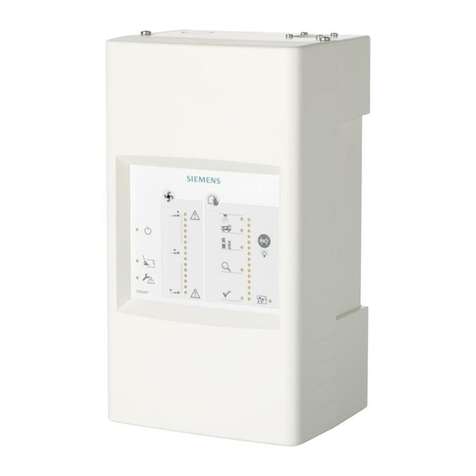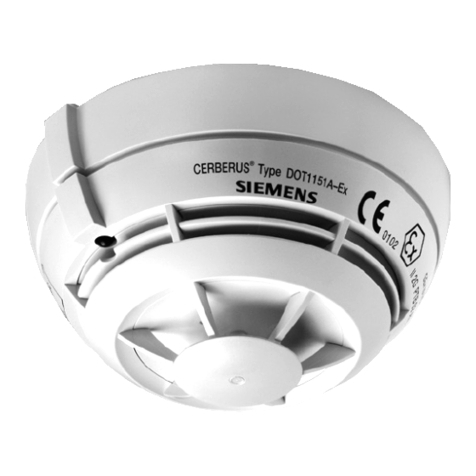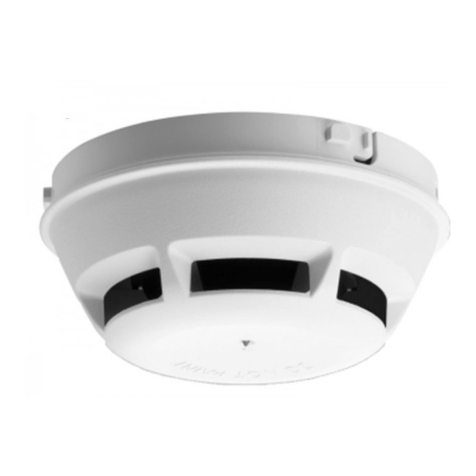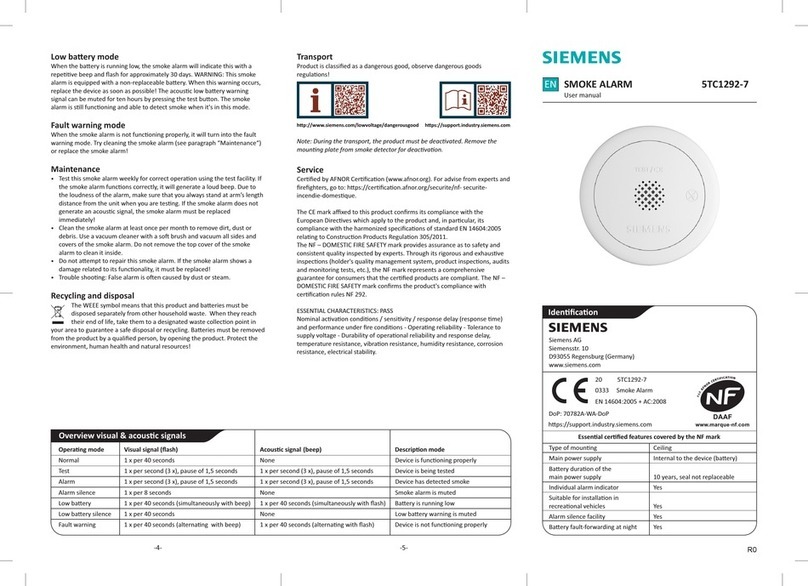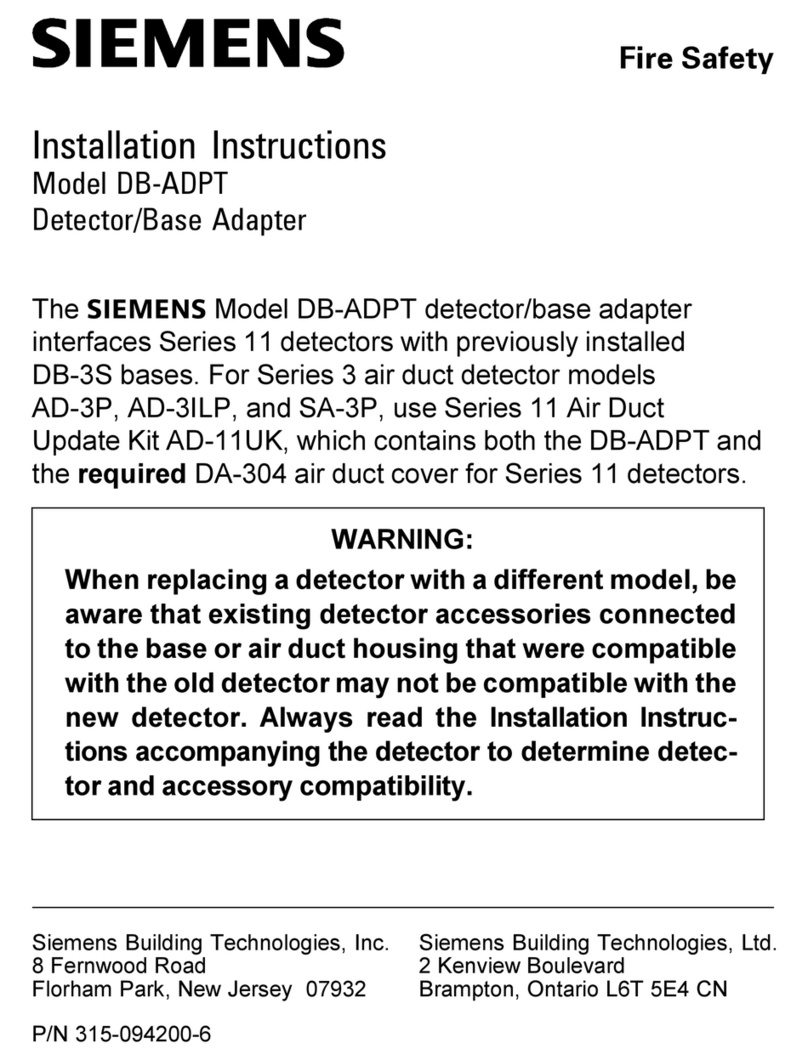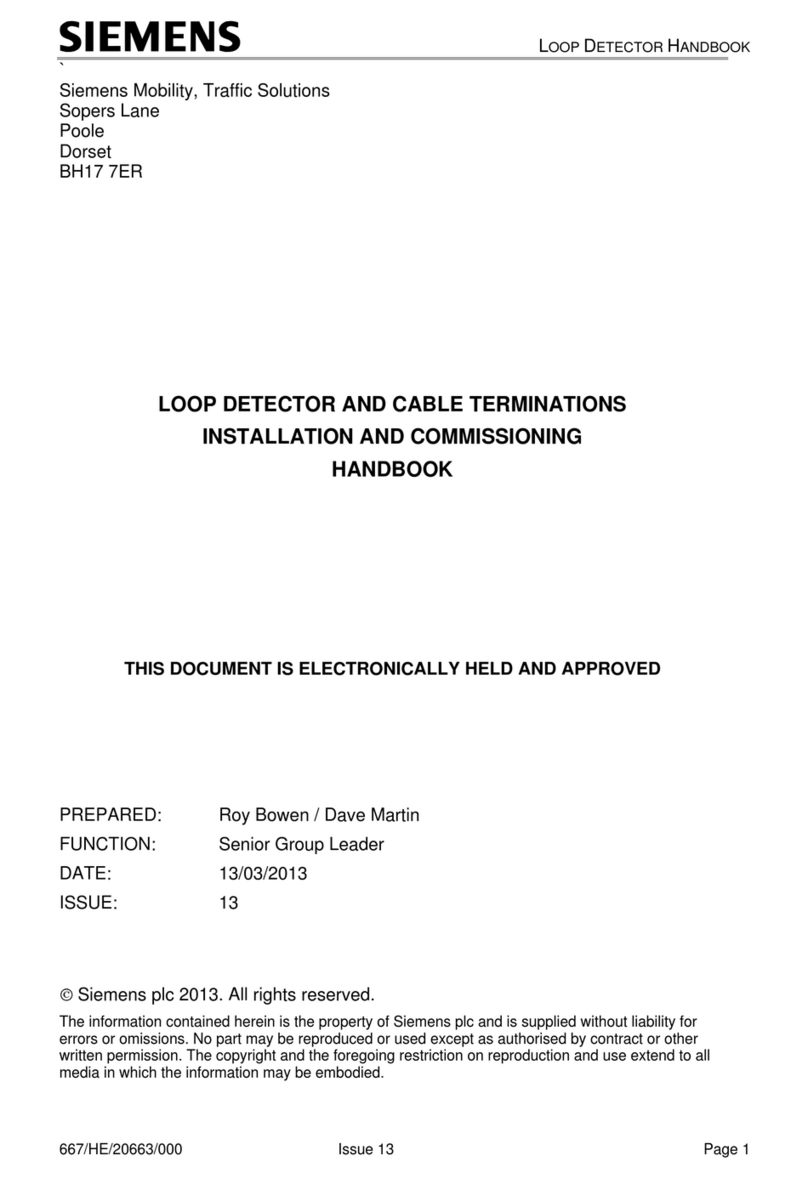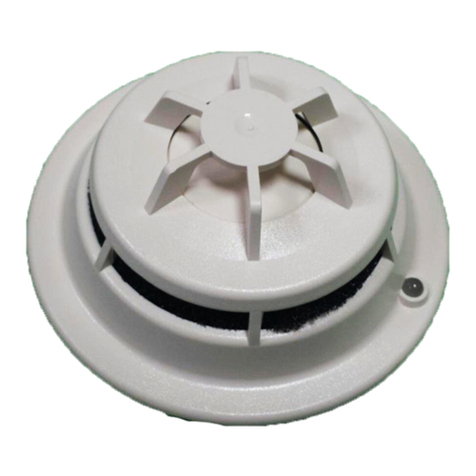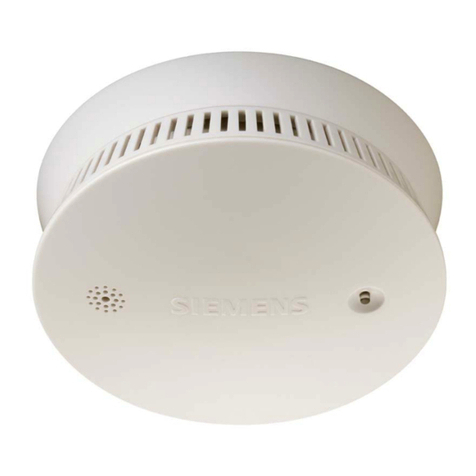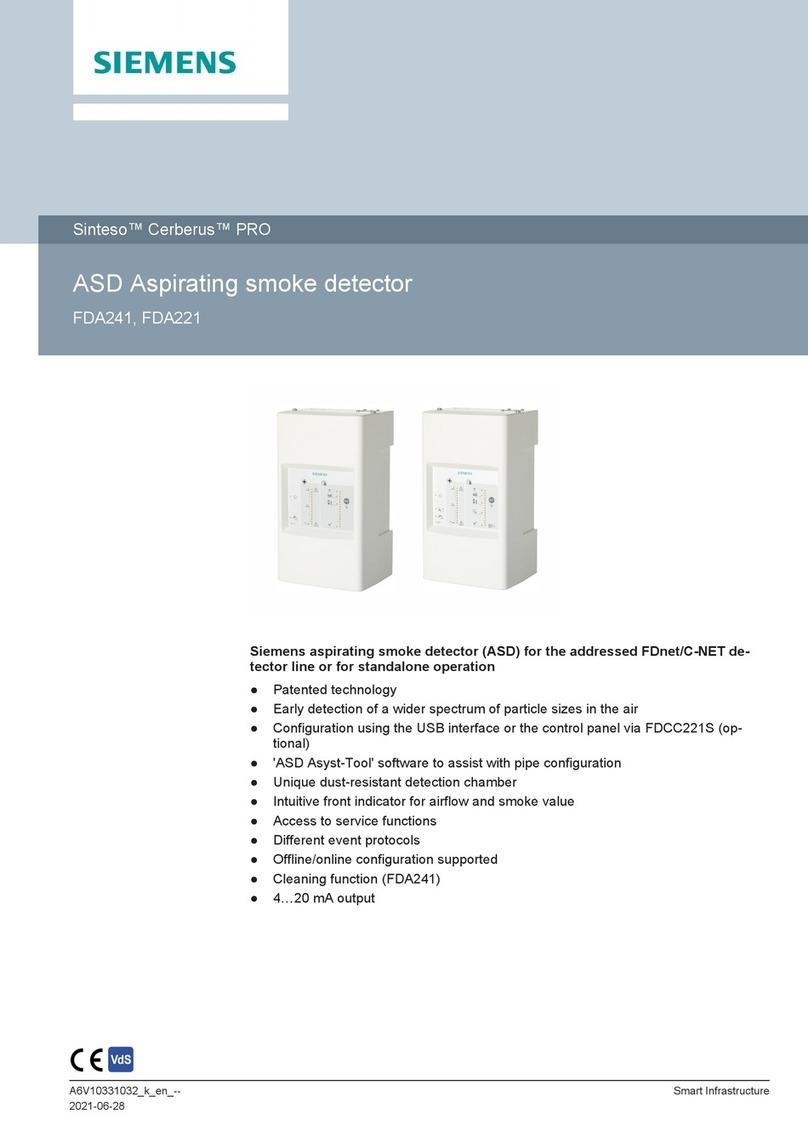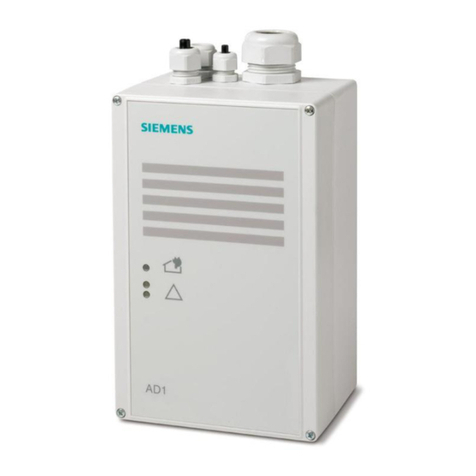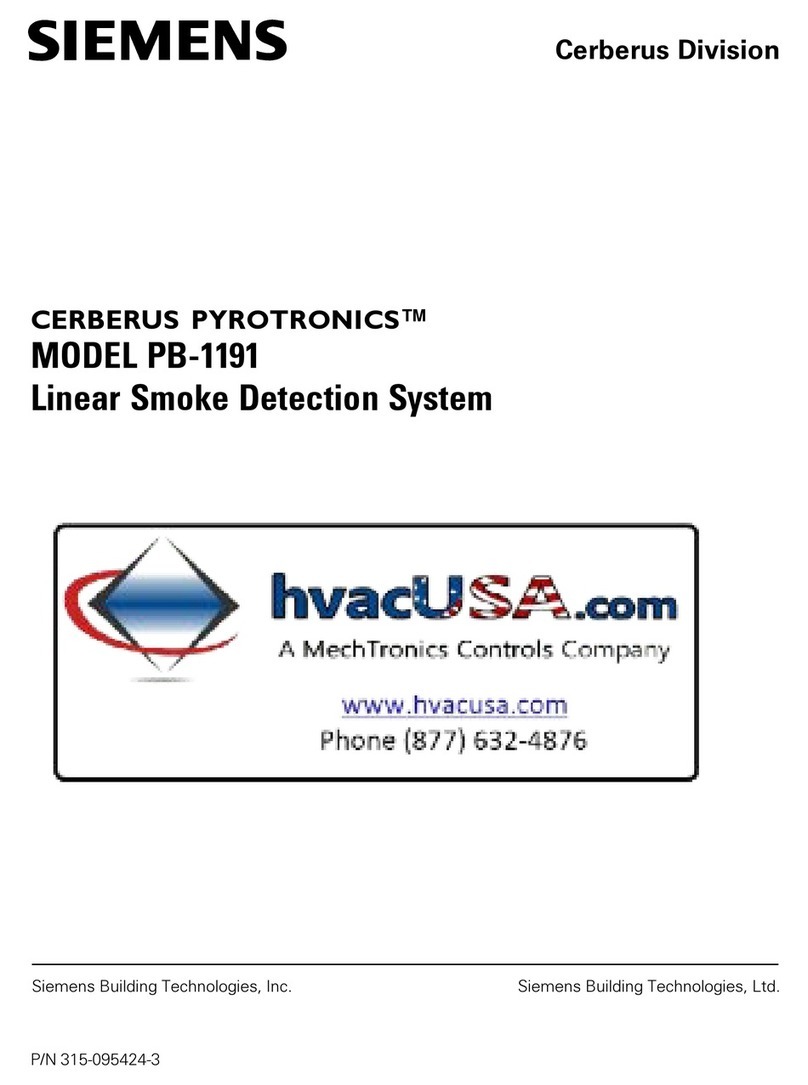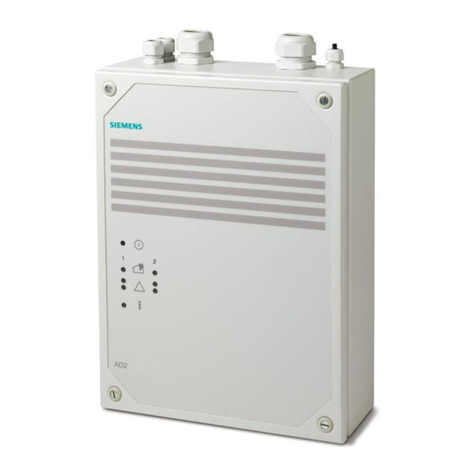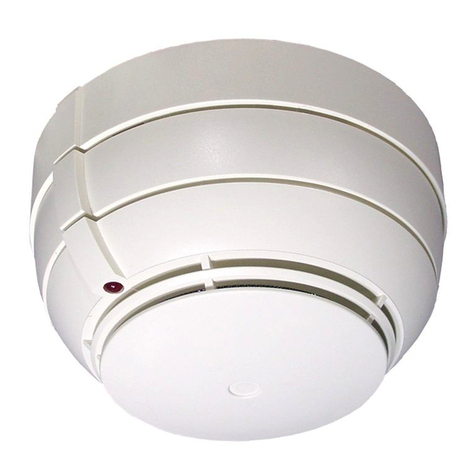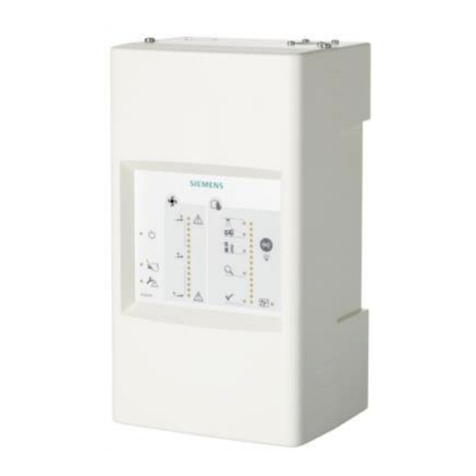
251653.41.16 "DS06" Seite 1 von 3 Page 1 of 3
Produkt- und Funktionsbeschreibung Product and Applications Description
Der DELTA reflex Rauchmelder SD9 (VdS) ist für den Einsatz
im Wohn- und Geschäftsbereich konzipiert, überall dort, wo
keine Brandmeldeanlage vorgeschrieben ist. Der Rauchmelder
erkennt frühzeitig den bei Bränden entstehenden Rauch und
gibt optisch (blinkendes Lichtsignal) und akustisch (pulsierender
Signalton, 85 dB(A)) Alarm.
Die Rücksetzung des Alarms erfolgt automatisch, wenn der
Rauch aus der Messkammer vollständig entwichen ist.
Die Funktionskontrolle des Rauchmelders, z.B. auf allmähliche
Verschmutzung (Staubablagerung), erfolgt durch die Betätigung
des Testknopfes für mindestens 4 s. Dabei blinkt die LED im
0,5 s-Takt so lange, wie der Testknopf gedrückt ist. Bei
korrekter Funktion werden 3 kurze Signaltöne abgegeben, die
sich mit einer Pause von 1,5 s wiederholen, wenn man den
Testknopf weiterhin gedrückt hält.
Die Spannungsversorgung des Rauchmelders SD9 wird durch
eine handelsübliche 9 V Alkaline Block-Batterie sichergestellt.
Sinkt die Batteriespannung unter ein Mindestniveau, so meldet
der Rauchmelder zyklisch durch ein optisches und akustisches
Signal (kurzer Signalton) mindestens 30 Tage lang, dass die
Batterie gewechselt werden muss. Während dieser Zeit ist der
Rauchmelder voll funktionsfähig.
Um die Funktion des Rauchmelders sicherzustellen, ist eine
Montage des Melders ohne eingelegte Batterie nicht möglich
(Batteriefachkontrolle).
Produkt- und Funktionseigenschaften
•VdS zertifiziert
•batteriebetriebener Rauchmelder basierend auf dem
photoelektrischen Streulichtprinzip
•optische und akustische Alarmierung (85 db(A))
•Funktionstest mittels Testknopf
•Batteriewechselanzeige
•Batteriefachkontrolle
The DELTA reflex smoke detector SD9 (VdS) has been designed
for use in the residential and commercial sector, all around where
no alarm system is mandatory. In the event of a fire, the smoke
detector detects the development of smoke in good time and
issues an optical (flashing light signal) and an acoustical
(pulsating signal tone, 85 dB(A)) alarm.
The reset of the alarm is carried out automatically, when the
smoke has completely escaped the measuring chamber.
The functional check of the smoke detector e.g. for gradual
pollution (dust deposits) is carried out by pressing the test button
for more than 4 s. Thereby the LED is flashing in 0,5 s cycle, as
long as the test button is pressed. If the function is correct, 3 short
acoustic signals are issued, which are repeated with a break of
1,5 s, if the test button is still pressed.
The power supply of the smoke detector SD9 is ensured by a
conventional 9 V Alkaline block-battery. If the battery voltage
drops below a minimum level, the smoke detector reports that the
battery must be changed by sending a cyclical optical and
acoustic signal (short signal tone) for at least 30 days. During this
period, the smoke detector is fully functional.
To guarantee the function of the smoke detector, it is not possible
to install the detector without the battery being inserted (battery
compartment check).
Product and functional characteristics
•VdS approval
•Battery-operated smoke detector, based on the photoelectric
scattered light principle
•Optical and acoustic alarms (85 db(A))
•Functional test using the test button
•Display for battery replacement
•Battery compartment check
Bedienung, Betriebs- und Alarmsignale Operation, operational signals and alarm signals
Bild A
A1 Rauchmelder SD9
A2 Testknopf mit optischer Anzeige (Leuchtdiode)
A3 akustischer Signalgeber
A4 Aufkleber “Nicht überstreichen“
Die Bedienung des Rauchmelders erfolgt ausschließlich über
den Testknopf (A2). Dieser dient zur Funktionskontrolle des
Rauchmelders (A1) z.B. auf allmähliche Verschmutzung
(Staubablagerung). Zudem beinhaltet der Testknopf auch die
optische Anzeige (Leuchtdiode) für die Betriebs- und
Alarmsignale. Die akustische Alarmierung (Signalton) erfolgt
über den Signalgeber (A3).
Diagram A
A1 Smoke detector SD9
A2 Test button with visual display (LED)
A3 Acoustic signalling device
A4 Sticker “Do not paint”
The operation of the smoke detector is carried out solely via the
test button (A2). This is used for the functional check of the smoke
detector (A1) e.g. for gradual pollution (dust deposits). The test
button also contains the visual display (LED) for the operational
and alarm signals. The acoustic alarm (signal tone) is carried out
via the signalling device (A3).
Bedienung, Betriebs- und Alarmsignale Operation, operational signals and alarm signals
Signal
optisch akustisch Zustand
Blinkimpuls ca.
im 32 s -Takt -- normale Funktion
Blinkimpulse
ca. im 0,5 s-
Takt, so lange
Testknopf
gedrückt
3 kurze
Signaltöne
ca. 1,5 s
Signalpause
Test
O.K.
Kein Blinken Kein Signalton Test
nicht O.K.
Blinkimpulse
ca. im 0,5 s-
Takt
3 kurze
Signaltöne,
ca. 1,5 s
Signalpause
Rauchalarm
(lokal)
Blinkimpuls ca.
im 32 s -Takt
kurzer
Signalton ca. im
32 s - Takt
Meldung Batterie
schwach (30 Tage)
Batteriewechsel Bild B
Wird die Untergrenze der Batteriespannung erreicht bzw.
unterschritten, so wird dies akustisch und optisch angezeigt
(siehe Tabelle Betriebs- und Alarmsignale). Tauschen Sie dann
die Batterie umgehend aus.
1. Das aus zwei Teilen bestehende Gerät (Halterung B1 und
Rauchmelder B2) durch eine Drehbewegung gegen den
Uhrzeigersinn öffnen.
2. Den Batteriedeckel (B3) öffnen, die Batterie (B4) aus den
Batteriefach entnehmen und abklemmen.
3. Die neue Batterie richtig gepolt anklemmen, in das
Batteriefach einlegen und den Batteriedeckel schliessen.
ACHTUNG:
Es dürfen nur 9 V Alkaline Batterien des Typs Eveready 522,
1222, 216; Duracell MN1604; Gold Peak 1604P, 1604S;
Energizer 522 oder gleichwertige Typen verwendet werden.
4. Langlöcher am Rauchmelder auf die Führungsnuten am
Montagehalter setzen, an den Montagehalter drücken und
den Rauchmelder durch Drehbewegung im Uhrzeigersinn
verrasten.
ACHTUNG:
Nur mit eingelegter Batterie lässt sich der Rauchmelder im
Montagehalter fixieren.
5. Führen Sie den Funktionstest durch (siehe Seite 3).
Signal
optical acoustic Status
flashing pulse approx.
in 32 s cycle -- normal function
flashing pulses
approx. in 0,5 s
cycle,as long as
test button is
pressed
3 short signal
tones,
approx. 1,5 s
signal break
test
O.K.
no flashing LED no signal
tone test
not O.K.
flashing pulse approx.
in 0,5 s cycle
3 short signal
tones,
approx. 1,5 s
signal break
smoke alarm
(local)
flashing pulse
approx. in 32 s cycle
short signal
tone approx.
in 32 s cycle
signals that battery
is weak
(30 days)
Battery replacement Diagram B
If battery voltage reaches or falls below the lower limit, this is
displayed both visually and acoustically (see table of operational
signals and alarm signals). In this case replace the battery
immediately.
1. Open the device consisting of two parts (module bracket B1
and smoke detector B2) by turning it anti-clockwise.
2. Open the battery cover (B3), remove battery from the battery
(B4) compartment and disconnect it.
3. Connect the new battery with the correct polarity, insert it into
the battery compartment and close the battery cover.
CAUTION:
Only 9 V Alcaline batteries of the type Eveready 522, 1222, 216;
Duracell MN1604; Gold Peak 1604P, 1604S; Energizer 522 or
equivalent types should be used.
.
4. Line up the slots of the bracket and the detector. Push the
detector onto the mounting bracket and lock in place by turning
it clockwise.
CAUTION:
The smoke detector can only be fixed in the bracket when the
battery has been inserted.
5. Carry out the functional test (see page 3).
Blatt 1 von 3, 2516534116 "D S0 6"
Die verbrauchte Batterie ist
entsprechend den geltenden Vor-
schriften zu entsorgen The exhausted battery must be
disposed of in accordance with the
appropriate regulations
DELTA reflex
Siemens AG
P.O. Box 10 09 53
93009 Regensburg
G206050
08
0786-CPD-20263
EN 14604
2005
Rauchmelder SD9, titanweiß 5TC1 295
Smoke detector SD9,
titanium white
Bedien- und Montageanleitung
Operating and mounting instructions
Stand: Januar 2008
Issue: January 2008

